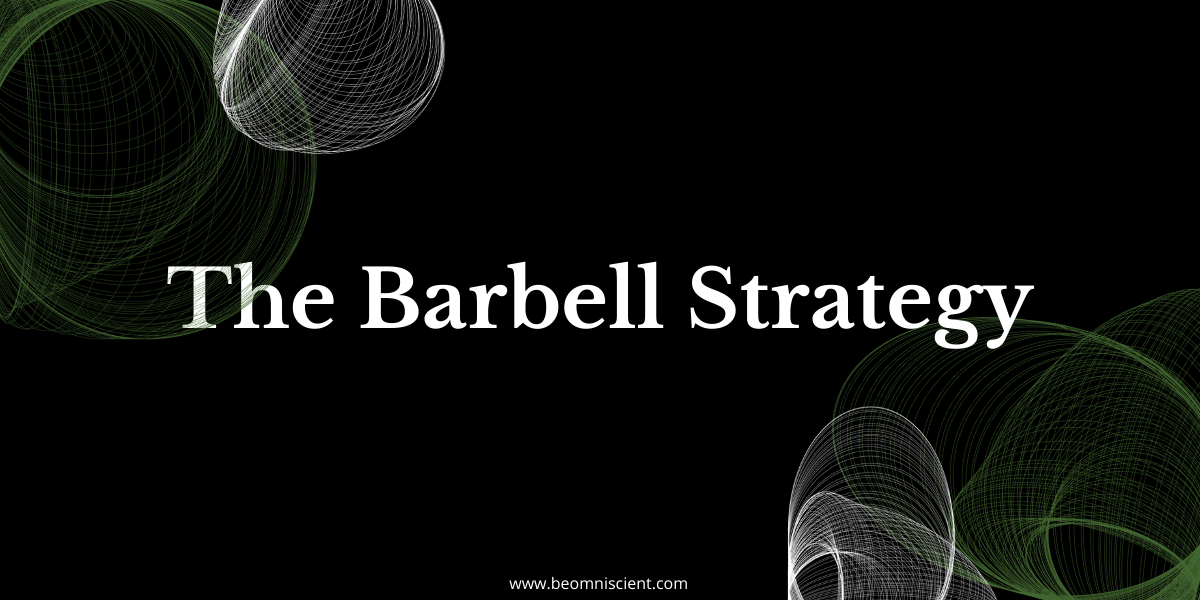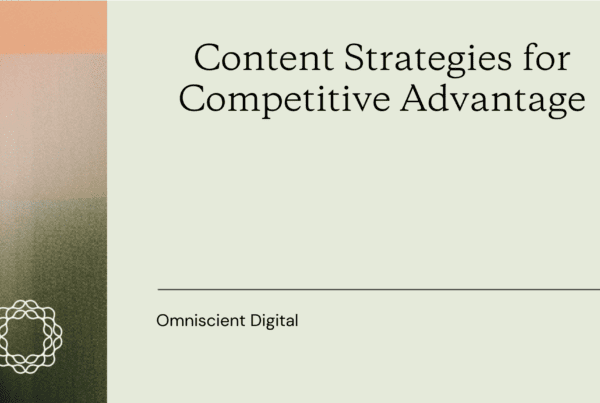
The “Barbell Strategy” is a holistic approach that seeks to balance your content marketing “portfolio” to make predictable and compounding revenue and generate spikes of attention and buzz.
This framework is built on portfolio theory, particularly on an investment strategy called the “Barbell Strategy.” This methodology was built to cap the downside of investing while allowing the investor to capture unpredictable spikes of high value.
We use lessons from financial theory to prove that you don’t have to choose one route or the other. While your scale may vary, you can both generate interest, brand awareness, and buzz, and build organic acquisition channels that make your CMO (and CFO) smile.
“Marry an accountant, but have occasional flings with rock stars.” – Nassim Nicholas Taleb
The death of most content marketing programs is due to a lack of coherent strategy.
Marketers see success stories, they see competitors doing content or hear that they should do content from conference speakers. They start producing content, copying what others are doing, “publish, publish publish,” and then…nothing.
No new traffic, no new leads, just a bunch of wasted time and money.
Why? They areedoing what others do without understanding the underlying reasons and strategy behind it.
There are many frameworks and strategies for content marketing; we use the Barbell Strategy.
It’s designed to limit risk, factors in uncertainty about historical data and the probability of a piece of content to succeed, and opens up the potential for unpredictable upside.
Weight Lifting and Esoteric Finance Strategy: What’s a “Barbell Strategy,” Anyway?
We’ve borrowed the term “Barbell Strategy” from Nassim Nicholas Taleb, a writer and quantitative financier.
A concept commonly applied in financial investing, the Barbell Strategy allocates investments into two bins at the extreme ends of a volatility spectrum. Resembling a bimodal distribution, you have one bucket of investments in safe assets (such as cash or bonds) and another bucket of investments in highly volatile, speculative assets (cryptocurrencies, stocks, options, angel investing).
Typically you’ll index more heavily, say 90% of your investment, in low-volatility assets and about 10% in high-volatility assets.

By balancing your portfolio like this, you cap your risk of financial ruin while still participating in potential positive black swan events and unpredictable upside from the risky side of your portfolio.
The 90% of low-risk investments allow you to survive; the 10% allows you to capture optionality.
This is in contrast to a “bullet strategy,” in which you’re entirely invested in mid-risk investments, which Nassim Taleb argues actually hide much more risk than they appear because by taking the middle, or the bullet strategy, you’re missing out on both safety and the potential of massive upside.
This middle-brow strategy is the one that most content programs follow. You’re squeezed to the middle of the pack, where competition is thickest and big wins are unlikely.
First, before diving into what the Barbell Content Strategy can look like in motion, let’s establish the reasons for using it and our beliefs that make this an effective path.
The Barbell Strategy for Content Marketing
The barbell strategy, when applied to content marketing, indexes heavily on low-risk, keyword-driven content while keeping a flexible basket of speculative, experimental content.
We’ll name these two types of content Product-Led Content and Buzzworthy Content.
Product-Led Content
Product Led Content is analogous to your safe assets, created with the intent of driving product signups or purchases.
Each piece of content you plan and create in the name of this strategy is done so with your product in mind.
Ask yourself: “Does this content relate back to our product?” If the answer is “no,” it’s not product led content.
However, that doesn’t necessarily mean the content is all about getting people to buy your product, what you might consider “bottom of funnel content.” Product led content can span all stages of the buyer’s journey.
We think about the buyer’s journey in three stages: awareness, action, and decision.
At the aware stage, the buyer is still becoming aware of the problem they have or the topic they want to learn about. Examples of content that addresses the aware stage include:
- ”What is customer churn”
- “What is content strategy”
- “What are the benefits of kettlebell swings”
- “What is the difference in caffeine from coffee vs tea”
You can see that most of the content answers “what” questions.
In the action stage, the buyer is hoping to take action and seeks a deeper understanding of the next steps, or even how to do something. Examples of content that addresses the action stage include:
- “How to reduce customer churn”
- “How to create a content strategy”
- “Kettlebell swing video”
The more obvious action-oriented queries will show up in the form of how-to questions, but that isn’t always the case.
In the decision stage, the buyer has made a decision that they will do something and is trying to make the right decision. Examples of content that addresses the decision stage include:
- “Best customer feedback tools”
- “Best content strategy courses”
- “Sporting goods stores near me”
When you look back at the examples of content that address each stage of the buyer’s journey, you’ll notice that the queries aren’t about any particular product, but they can be tied indirectly to a product the reader may be interested in.
Buzzworthy Content
Buzzworthy Content is speculative content that’s created to attract backlinks, attention, social shares, partnerships, or connections. These goals might indirectly feed into business growth, but you should not try to directly attribute these activities to revenue.
More now than ever, link building is a slog. Journalists, marketers, and writers get dozens of templated email pitches from people hoping to snag a backlink everyday (we get them too).
The best way to get the job done is through content-led link building. You research what type of content is likely to generate buzz among influential publishers in your sphere and develop an outreach strategy to build links.
To clarify, Buzzworthy Content can end up driving leads or product sign-ups and Product Led Content can drive links or heck, even go viral, but these are exceptional cases.
It’s helpful to have two discrete buckets to help you decide the singular goal of each piece of content.
The idea is to index heavily on predictable, known channels while keeping an experimental bucket open for unknown channels that represent nonlinear potential.
The Risk/Benefit of the Two Content Barbells
What makes keyword-driven Product Led Content “safer” than speculative Buzzworthy Content?
The probability distribution of outcomes.
Whether a keyword’s estimated monthly search volume (MSV) or purchase intent (usually measured via cost per click) is truly accurate or not, the outcome of the post will roughly fall on a normal distribution.
For example, if a keyword is estimated at 500 MSV, you can predict that it will probably fall within 300-800, and at least 100-1000.
At a given keyword difficulty, you can get a rough estimate of how likely you are to rank for the keyword.
You can also build content growth models to try to try to predict your traffic growth and calibrate your prediction accuracy over time.
Where Product Led Content follows a normal distribution, Buzzworthy Content follows a power law.

This means most posts you produce won’t demonstrate large tangible results, but every once in a while, a large success pays for the rest of the failures.
This is similar to the approach in venture capital portfolio theory: what you’re after isn’t consistency of wins, but rather the effect size of a given win.
You’re trying to capture the upside of serendipity.
For many years, website traffic distribution has followed a sharp power law, and it seems articles that generate organic backlinks follow a similar law. Very few articles get the majority of backlinks and the rest of the articles get very few.
Just look at the results of any Buzzsumo content search:
Setting aside whether or not you want to write clickbaity content to get results, it isn’t probable that you can repeatedly reverse engineer articles that achieve 100K+ social shares.
Why not simply produce only SEO-driven, predictable content, then?
While it could work for some websites, it’s simply unlikely to work for you. Given the headstart your competitors might have had, you’ll need to generate spikes of attention with Buzzworthy Content.
You need something different enough worth sharing or linking to.
Unless you’re already working at a company with a domain rating of 80+, you’ll have to put in effort to build backlinks, capture attention, and get people to read your content. Once you amass some backlinks and authority, your Product Led Content can consistently generate returns.
You’ve gotta build that content flywheel!
Your Content Portfolio Will Change Over Time
As with an investment portfolio, your content portfolio will become more conservative with time.
That’s because you won’t need the leverage produced by Buzzworthy Content to build up your domain rating. That will allow you to improve your content economics by scaling up content production, lowering the cost per article, and getting the flywheel to work to your advantage.
After enough time and effort, you’ll be able to rank for pretty much any piece of content you publish, increasing the expected value of each article as the probability of ranking on page one of the search results increases and the cost of producing content decreases.
How will you adjust your content portfolio?
In our opinion, the worst thing that can happen with a content program is you invest time and resources into creating content, but don’t produce any positive results. This is a direct cost and opportunity cost.
The Barbell Content Strategy reduces that risk and puts you in a position to generate a linear return on your investment in a worst case scenario while setting yourself up for a best case scenario of capturing surprising and unmodeled upside.
What does your content portfolio look like and how will you adjust it to increase your return on investment?



